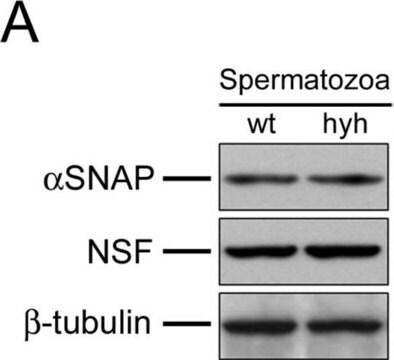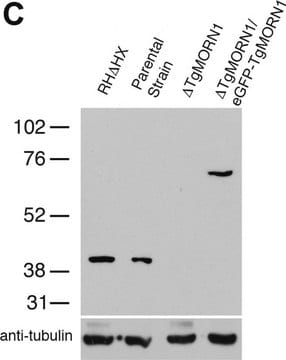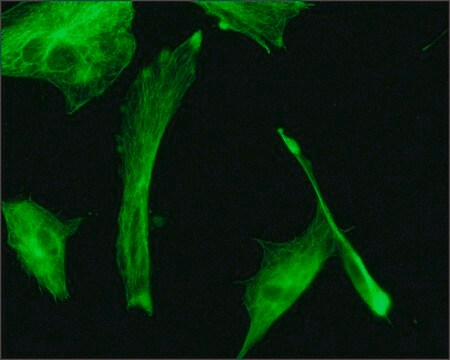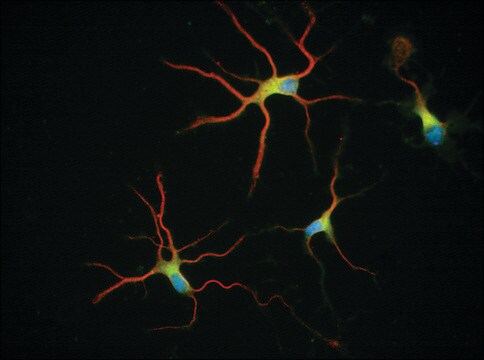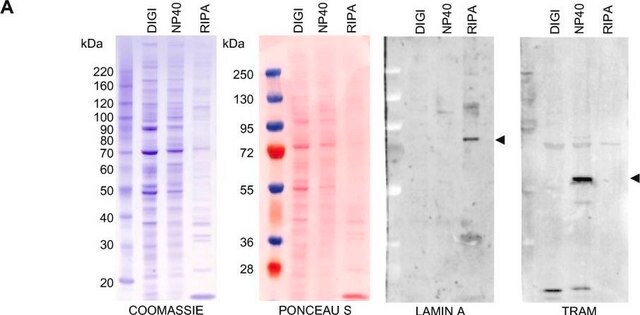T8328
Anti-β-Tubulin antibody, Mouse monoclonal
~2.0 mg/mL, clone AA2, purified from hybridoma cell culture
Synonyme(s) :
Beta Tubulin Antibody Sigma, Beta Tubulin Antibody Sigma - Monoclonal Anti-β-Tubulin antibody produced in mouse, Anti-TUBB, Anti-Tubulin, beta
About This Item
Produits recommandés
Source biologique
mouse
Niveau de qualité
Conjugué
unconjugated
Forme d'anticorps
purified from hybridoma cell culture
Type de produit anticorps
primary antibodies
Clone
AA2, monoclonal
Forme
buffered aqueous solution
Poids mol.
antigen ~50 kDa
Espèces réactives
human, mouse, rat, bovine
Conditionnement
antibody small pack of 25 μL
Concentration
~2.0 mg/mL
Technique(s)
immunocytochemistry: suitable
immunohistochemistry: suitable
immunoprecipitation (IP): suitable
western blot: 1-2 μg/mL using Neuro-2a cell extract
Isotype
IgG1
Numéro d'accès UniProt
Conditions d'expédition
dry ice
Température de stockage
−20°C
Modification post-traductionnelle de la cible
unmodified
Informations sur le gène
human ... TUBB(203068)
Description générale
Spécificité
Immunogène
Application
Actions biochimiques/physiologiques
B2702 peptide binds to β-tubulin and inhibits natural killer (NK) cell cytotoxicity and it influences microtubule polymerization, which damages cytoskeleton organization and chaperone-like activity of tubulin. Mutation in the gene leads to various neuronal migration disorders such as lissencephaly, pachygyria and polymicrogyria malformations.
Forme physique
Stockage et stabilité
For extended storage, freeze at -20 °C in working aliquots. Repeated freezing and thawing, or storage in “frost-free” freezers, is not recommended. If slight turbidity occurs upon prolonged storage, clarify the solution by centrifugation before use. Working dilution samples should be discarded if not used within 12 hours.
Clause de non-responsabilité
Vous ne trouvez pas le bon produit ?
Essayez notre Outil de sélection de produits.
En option
Code de la classe de stockage
10 - Combustible liquids
Point d'éclair (°F)
Not applicable
Point d'éclair (°C)
Not applicable
Équipement de protection individuelle
Eyeshields, Gloves, multi-purpose combination respirator cartridge (US)
Certificats d'analyse (COA)
Recherchez un Certificats d'analyse (COA) en saisissant le numéro de lot du produit. Les numéros de lot figurent sur l'étiquette du produit après les mots "Lot" ou "Batch".
Déjà en possession de ce produit ?
Retrouvez la documentation relative aux produits que vous avez récemment achetés dans la Bibliothèque de documents.
Les clients ont également consulté
Articles
Frequently asked questions about neural stem cells including NSC derivation, expansion and differentiation.
Notre équipe de scientifiques dispose d'une expérience dans tous les secteurs de la recherche, notamment en sciences de la vie, science des matériaux, synthèse chimique, chromatographie, analyse et dans de nombreux autres domaines..
Contacter notre Service technique



